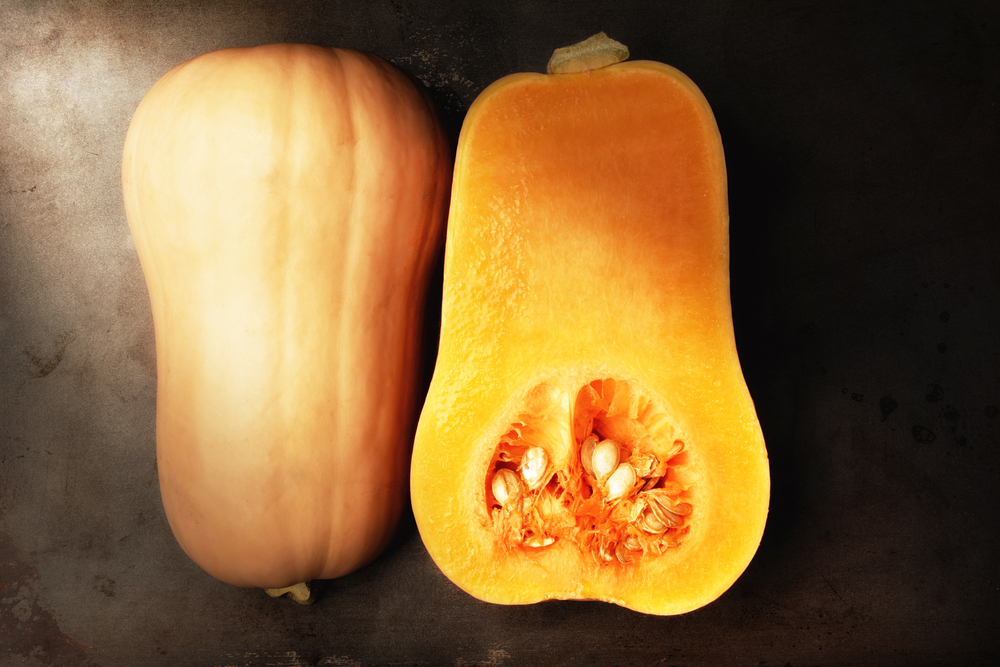There are lots of different squash available now in all their fabulous shapes, colours and sizes, but the butternut variety, showing its understated beauty in the picture, is a reliable option. Unlike some of the more exotic squash, it is relatively easy to prepare, particularly as regards peeling, and it is also fairly quick to cook, unlike some of it’s more solid relatives.
A simple way to cook Butternut Squash
- Preheat the oven to 180c.
- Cut the squash in half lengthwise.
- Scoop out the seeds and set them aside.
- Rub each of the cut sides with a little rapeseed or olive oil and a pinch of sea salt flakes and bake them, skin side up, on a baking tray in the preheated oven for about 45 minutes or until the flesh is meltingly soft.
The flesh can be scooped out and used as a substitute for mashed potatoes on shepherd’s pie. Or the scooped-out flesh can be mixed with some grated hard cheese, or some soft cheese cut into small pieces, and some finely sliced cabbage leaves, spinach or other green leaves and some finely chopped parsley or sage or some thyme leaves. Pile the mixture back into the squash shells and bake in the oven until piping hot. Sprinkle with some baked crumbs before serving or serve the crumbs on the side.
Squash cooked in this way, without the salt, also makes an excellent food for weaning babies and can be frozen in small, convenient quantities.
The skins of the baked squash, like potato skins, can also be eaten. They are especially good cut into manageable pieces, rubbed with oil and sea salt flakes and baked in the oven at 200c for about 15 minutes or until they become crispy and browned at the edges. Eat them straight away with soured cream or Labneh and soft herbs such as snipped chives or chopped parsley or coriander or mint.
The seeds from the squash, sprinkled with sea salt flakes and olive oil, can be spread over an oiled baking tray and baked at 180c for 20 to 30 minutes or until they are golden brown and crisp. If you don’t want to eat them straight away, let them cool and then store them in a clean jar, covered with a lid. They will keep well for several weeks but they are so good to eat you will probably use them up very quickly.
Butternut Squash Soup
Simple ingredients producing a big flavour. Take this soup to another level with the added extras of labneh and chopped coriander, mint or parsley.
Enough for 4-6
1 large butternut squash, about 1.5kg, unpeeled weight
1 large onion, peeled and chopped finely
3 tbsp olive oil or a generous lump of good butter
1 litre vegetable stock or water
Sea salt flakes and freshly ground black pepper
Optional extras: Labneh, or thick Greek style yogurt, and some chopped coriander, mint or parsley
You will also need a large pan with a well-fitting lid and a stick blender or liquidiser.
- Use a vegetable peeler to peel the squash, halve it lengthwise and remove the seeds and fibrous bits and chop the flesh into, approximately, 3cm cubes.
- Heat the oil or butter in a large pan over low heat, add the onion, cover the pan with a lid and let the onion cook gently for 10 minutes or so until it is starting to soften.
- Add the prepared squash and the stock, or water and stir everything together. Cover the pan with the lid and continue to cook over low heat until the vegetables are meltingly soft. This will take at least 30 minutes.
- Remove the pan from the heat and allow the mixture to cool for 5 minutes or so before blitzing with a stick blender or liquidiser.
- Most importantly, taste and season the soup with sea salt flakes and freshly ground black pepper.
- Reheat the soup before serving just as it is or with the added embellishments of the optional extras
Sherbhert champions delicious, healthy and sustainable food where its production minimises environmental damage, exploitation, animal suffering and subsequent processing. Sherbhert’s recipes are simple and use mainly UK seasonal produce sourced as locally as possible.

